Spring salmon on the River South Esk, Scotland: Scottish Marine and Freshwater Science Vol 7 No 10
Report of a three year project carried out by Marine Scotland to investigate the spring component of the River South Esk salmon stock.
Part 4: Spring rod fishing effort
Objective: Is it possible to assess to what extent changes in rod fishing effort have accounted for the declining trend in rod catches of spring salmon?
4.1 Introduction
Rod catch data for salmon is frequently used to infer stock level in a given river. To do this, it is necessary to know, or be able to estimate, exploitation rate, such that:
Catch = Total number of fish available to the fishery x Exploitation rate
Exploitation rate by the rod fishery will depend on the number of days on which anglers fish, and how effective that effort is, such that:
Exploitation rate = Number of angler days x Mean effectiveness
Effectiveness of anglers will be influenced by many factors (Smith et al., 1996) including the amount of time they spend fishing on any given day, their skill level, the quality of their tackle and the catchability of the fish, such that:
Effectiveness = Time on water x Skill level x Quality of tackle x Catchability of fish
There is rarely, if ever, a good account of inter-annual variations in these factors, and in practical terms, exploitation rate is usually assessed only by comparing catches and counts. Nevertheless, it is evident that the number of angler days on its own will be a major determinant of exploitation rate (Smith et al., 1996). It is widely recognised that effort data would be useful for increasing inferences from rod catches. However, such information is difficult to source.
Despite the national spring salmon rod catch stabilising in recent years, rod catch on the River South Esk has continued to decline during spring. The overall aim of this project is to assess the causes underlying the continuing decline. One consideration is rod fishing effort (hereafter referred to as "effort") and whether there are any trends in effort over recent years. Namely, do declining catches of spring salmon on the River South Esk reflect a declining trend in effort? Or, has effort remained relatively stable against a backdrop of declining catches? Data is therefore required on rod fishing effort. While it is acknowledged that other factors affecting the number of fish caught by the rod fishery may also have changed (i.e. the total number of fish available to the fishery, exploitation rate, angler effectiveness), rod effort is the factor we have the best chance of quantifying in the context of the present study.
In this context, effort can be thought of as the amount of use that anglers are making of a fishery. This might be measured in several ways, for example bookings, the number of anglers fishing a beat per day or per week, or the number of rods fishing over a specified time period. Such data may therefore occur in a diverse range of formats, particularly given the disparate sources from which they are likely to be sourced. The physical format of the data (e.g. whether in the form of paper records or in an electronic form such as a spreadsheet), the consistency of the data over time, and the consistency of the data among different providers are all important considerations. Furthermore, it is necessary to identify who might have such data and then request any of sufficient quality to be informative. In the context of the present study, Marine Scotland is interested only in effort data for the spring months (February to May inclusive) in relation to rod catches of early running spring salmon. An analysis of effort data during spring (February to May inclusive) on the River South Esk over the period 2002 to 2012 inclusive is presented here.
4.2 Methods
Data requesting process
Using the annual catch returns submitted to Marine Scotland, rod fisheries accounting for the greatest proportion of the spring salmon catch on the River South Esk were identified. For all catch return forms, the data considered were the reported rod catch (retained & released) for MSW salmon caught between February and the end of May inclusive over the period 1997 to 2013 inclusive for the South Esk river. The mean annual catch was calculated for each form and the forms were ranked from 1 to 26 in terms of their overall contribution to the spring catch (1 = greatest contribution). Using data from 10 out of the 26 forms accounted for 2,308 out of 2,713 fish (85.1 %). The proprietors of the 6 fisheries associated with these 10 forms were identified and contacted via letters ( Appendix 4.5), phone calls and face-to-face meetings.
Data treatment
Effort data were received from one fishery proprietor. These data were used in conjunction with the associated official catch statistics for that fishery in the following analyses.
The effort data took the form of bookings for the period 2002 to 2012 inclusive. The data for the first five years of the time series (2002 to 2006 inclusive) identified whether or not a given beat was let on a given day. The data for the last six years of the time series (2007 to 2012 inclusive) provided equivalent information, but also included information on the number of rods booked per beat day let.
The data for the first five years of the time series were considered "low definition" data since they did not include information regarding the number of rods booked per beat for those days on which a given beat was let. The data for the last six years of the time series were considered "high definition" data since they included information regarding the number of rods booked per beat for those days on which a given beat was let. It was possible to simplify the high definition data into a format analogous to the low definition data, thus harmonising data in a consistent format for the entire time series (2002 to 2012 inclusive).
Low definition data were used to calculate the number of beat days let as a percentage of the number of beat days available in the spring of each year from 2002 to 2012 inclusive. The number of beat days let was calculated as the number of days on which any of the available beats were let in the spring of that year. The number of beat days available was calculated as the number of beats available multiplied by the number of angling days available in the spring of that year.
To determine if there was a temporal trend in effort, a random walk model was fitted to the data on the percentage of beat days let annually between 2002 and 2012. A bootstrap procedure was used to generate confidence intervals to determine if there was a significant difference at the 5 % level between 2002 and subsequent years.
Catch data for the fishery were used to investigate whether there was a relationship between catch and effort (calculated as described above) for the period 2002 to 2012 inclusive. Catch was taken as the total spring rod catch (reported rod catch (retained & released) for MSW salmon caught between February and the end of May inclusive) for the fishery for each year between 2002 and 2012 inclusive. "Standardised catch", expressed as the catch for each year as a percentage of the highest value in the time series, was used as the y-variable so as not to show absolute catch figures. Effort was expressed as the percentage of beat days let per year. Catch per Unit of Effort ( CPUE) was expressed as the absolute catch divided by the percentage of beat days let per year. A smoother was fitted to the CPUE time series. CPUE values were assumed to follow a gamma distribution (constant coefficient of variation) with the smoother fitted on the log-link. A test of trend was performed by comparing the smoother fit to a fit with only an intercept term. Given the small sample size, a bootstrapped F-test was used to assess significance.
High definition data were used to examine whether there were any trends in the number of rods booked per beat day let for the period 2007 to 2012.
4.3 Results
Percentage of beat days let per year, 2002 to 2012
Figure 4.3.1 shows that the number of beat days let in 2003 was not significantly different from 2002, and that 2004 was significantly different, though the difference was small. However, there is evidence of a substantial decline in 2005, with all the years from 2005 to 2012 characterised by a significantly lower percentage of beat days let than in 2002.
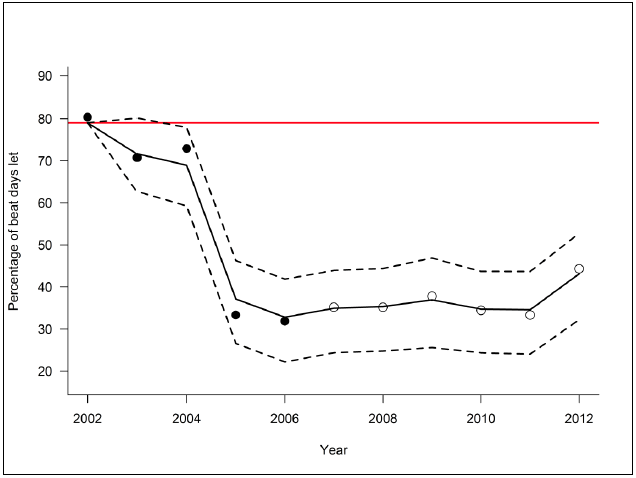
Figure 4.3.1: Observed and modelled temporal variability in the percentage of beat days that were let annually between 2002 and 2012. The solid line shows the model fit, with the dashed lines indicating pointwise 95 % confidence intervals for the difference between the fit and the 2002 estimate. The red line shows the 2002 estimate for reference: when the dashed lines fall below the red line, the fitted trend is significantly different from the 2002 estimate.
CPUE, 2002 to 2012
There was no evidence of a significant linear trend between effort and standardised catch for the period 2002 to 2012 inclusive (correlation: r = 0.113, P = 0.740; Figure 4.3.2). However, this appeared to be driven largely by an obvious outlier with a large standardised catch ( Figure 4.3.2). This data point was from 2006 when a particularly large catch (in the context of the time series under consideration) was reported, being 195 % of the next largest value in the time series ( Figure 4.3.2).
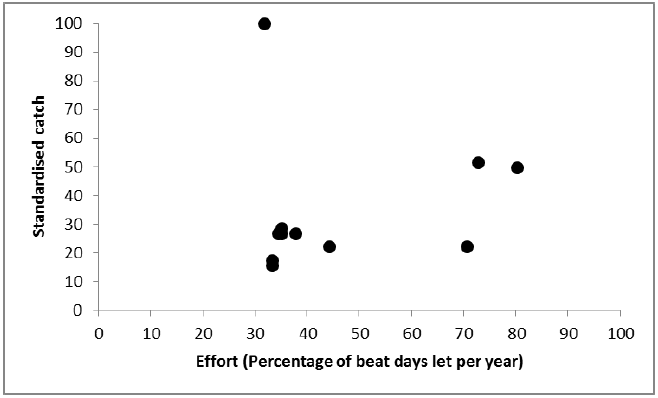
Figure 4.3.2: Plot of effort (expressed as the percentage of beat days let per year) against standardised catch (expressed as the catch for each year as a percentage of the highest value in the time series) for the period 2002 to 2012 inclusive.
Similarly, there was no evidence of a significant linear trend in CPUE (expressed as the absolute catch divided by the percentage of beat days let per year) over the time series 2002 to 2012 inclusive (correlation: r = - 0.055, P = 0.873; Figure 4.3.3). However, the same outlier as mentioned above appeared to be affecting this result ( Figure 4.3.3).
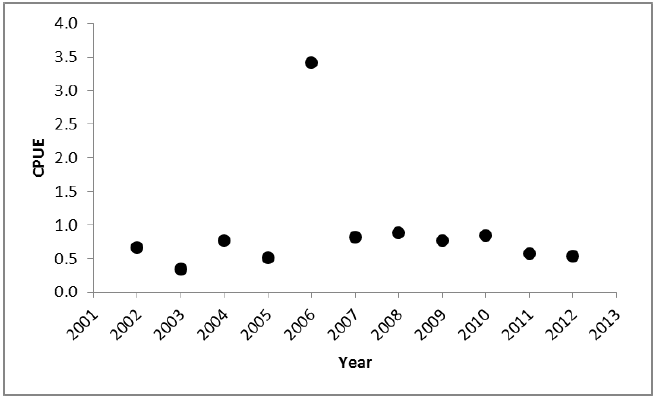
Figure 4.3.3: CPUE (expressed as the absolute catch divided by the percentage of beat days let per year) over the time series 2002 to 2012 inclusive.
Removing 2006 from the time series revealed a significant positive linear relationship between effort and standardised catch (regression: r 2 = 54.8 %, F 1, 8 = 9.69, P = 0.014; Figure 4.3.4). Thus, years associated with a relatively high standardised catch tended to be those in which effort was also relatively high ( Figure 4.3.4).
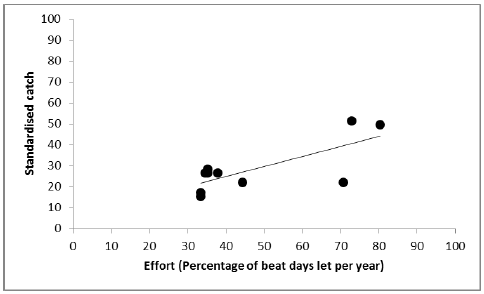
Figure 4.3.4: Plot of effort (expressed as the percentage of beat days let per year) against standardised catch (expressed as the catch for each year as a percentage of the highest value in the time series) for the period 2002 to 2012 inclusive, excluding 2006. A line of best fit is shown to illustrate the significant linear trend between standardised catch and effort over the period 2002 to 2012 inclusive, excluding 2006.
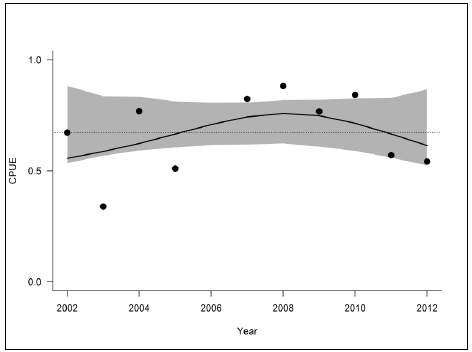
Figure 4.3.5: CPUE (expressed as the absolute catch divided by the percentage of beat days let per year) over the time series 2002 to 2012 inclusive, excluding 2006. The solid line shows the fitted smoother, with the shaded region indicating the reference bands for the difference between the smoother and an intercept only model. As the smoothed fit is always inside the reference bands the trend is not significantly different from a straight line (indicated by the dashed line).
CPUE across the time series (excluding 2006) varied by a factor of 2.6 from a minimum of 0.34 in 2003 to a maximum of 0.88 in 2008. A smoother fitted to the CPUE data revealed no overall significant trend across the time series (permutation F-test, P = 0.370; Figure 4.3.5). However, although the overall trend was non-significant, the distribution of data points around the fitted smoother suggested a tendency for CPUE to increase during the initial part of the time series (broadly coinciding with the step-change in effort noted previously) before peaking and, in later years, returning to values observed during the initial part of the time series ( Figure 4.3.5).
Number of rods booked per beat day let, 2007 to 2012
Over the period 2007 to 2012 inclusive, the mean number of rods booked per beat day let during spring declined significantly over the period (regression: r 2 = 86.2 %, F 1, 4 = 25.01, P = 0.007; Figure 4.3.6). This trend was driven by a significant increase in the number of beat days let on which either 1 rod (correlation: r = 0.912, P = 0.011; Figure 4.3.7) or 2 rods ( r = 0.873, P = 0.023; Figure 4.3.7) were booked, and a significant decrease in the number of beat days let on which 4 rods were booked ( r = - 0.923, P = 0.009; Figure 4.3.7). The number of beat days let on which 3 rods were booked remained relatively constant ( r = 0.798, P = 0.057; Figure 4.3.7).
Figure 4.3.6
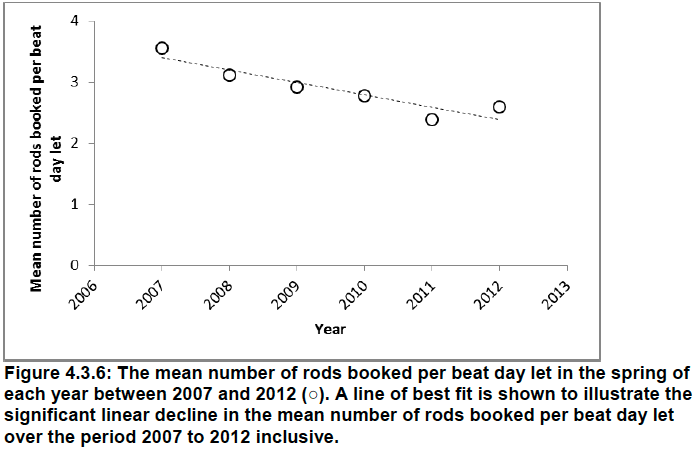
Figure 4.3.7
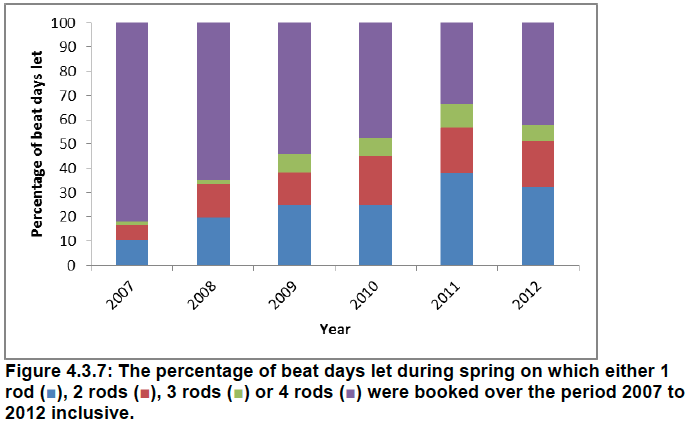
CPUE, 2007 to 2012
Over the period 2007 to 2012 inclusive, there was a significant negative correlation between CPUE and year ( r = - 0.833, P = 0.040, Figure 4.3.8).
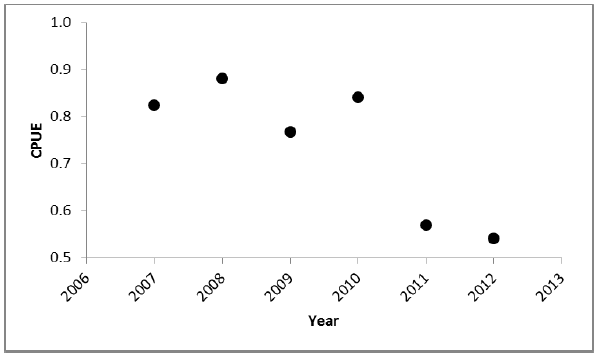
Figure 4.3.8: CPUE (expressed as the absolute catch divided by the percentage of beat days let per year) over the time series 2007 to 2012 inclusive.
4.4 Discussion
Percentage of beat days let per year, 2002 to 2012
Between 2002 and 2004, the percentage of beat days let per year remained relatively constant. However, there was a substantial decline in 2005, with all years from 2005 to 2012 characterised by a significantly lower percentage of beat days let than in 2002.
CPUE, 2002 to 2012
When the outlying year of 2006 was removed from the data series, there was a significant positive linear relationship between effort and standardised catch. Those years associated with a relatively high standardised catch tended to be those in which effort was also relatively high. There was no evidence of a trend in CPUE across the time series as a whole, although there was some evidence of a decline in later years (2007 to 2012).
Number of rods booked per beat day let, 2007 to 2012
Between 2007 and 2012, the mean number of rods booked per beat day let during spring declined significantly. This trend was driven by a significant increase in the number of beat days let during which either 1 rod or 2 rods were booked, and a significant decrease in the number of beat days let during which 4 rods were booked. The number of beat days let during which 3 rods were booked remained relatively constant.
CPUE, 2007 to 2012
Between 2007 and 2012, CPUE declined significantly.
Low definition data for the period 2002 to 2012 provides evidence of a significant reduction in rod fishing effort on a rod fishery which contributes substantially to the overall reported spring salmon rod catch on the River South Esk. Additionally, the significant reduction in the mean number of rods booked per beat day let can be interpreted as a reduction in effort over the period 2007 to 2012, and this coincides with a significant reduction in CPUE over the same period.
It should also be noted that the period 2007 to 2012 occurs in the latter part of the time series under consideration, when effort is lower than in the early years of the time series. Furthermore, with the exception of a single outlying year (2006), there was a significant positive relationship identified between effort and catch. In other words, the more effort expended in the fishery, the higher the resultant catch. Although there was no overall trend in CPUE across the time series, the step-change reduction in effort between 2004 and 2005 coincided with relatively high CPUE values in the next few years. Thereafter, CPUE values tended to decline in the latter part of the time series, although spring rod catch appears to recover a little by 2010 onwards (Figure 1.3.4 b). These data confirm that while, in the absence of other abundance indicators, rod catch may be used as a proxy for stock size, such a measure may be confounded by changes in rod effort.
Of particular note is the value of the high definition data in this study. Low definition data was successful in detecting a step-change in effort post-2004 and allowed a significant linear decline in CPUE to be identified between 2007 and 2012. However, it is only with the high definition data that the reduction in effort over the period 2007 to 2012 becomes apparent. Thus while it is recognised that measuring fishing effort may increase the reliability of fishery data as a proxy for stock abundance, such data needs to be of a sufficiently high quality.
When considering these results, it is necessary to consider the limitations of the data. For example, for the years in which the number of rods booked per beat day let was known, it is possible that not all booked rods turned up to fish on the day. Furthermore, individual rods may have fished for different periods of time (e.g. just a morning vs. all day), and angler skill is likely to vary among individuals. It is also necessary to consider whether these results for a single fishery apply to the River South Esk more generally. When seeking fishery proprietors for possible data supply, only those fisheries accounting for the greatest proportion of the reported spring salmon rod catch were contacted. We can therefore be confident that although the data presented here are from only one fishery, they do at least originate from a fishery contributing substantially to the overall spring salmon rod catch on the River South Esk. In this regard, it is disappointing that more data were not available for inclusion in the study. However, effort data in a consistent format collected over a reasonable time period and relating to a consistent fishery is notoriously difficult to source. Previous attempts by Marine Scotland to collate rod fishing effort data also resulted in very few positive returns. For studies such as this, rod effort data collected in a systematic and consistent fashion is required in order to draw any firm conclusions.
The value of the data, although undoubtedly useful, would have been strengthened further had it been available in a consistent format throughout. Low definition data were available for the entire time series and therefore allowed examination of effort across a reasonable time period (11 years). However, for six of these years, high definition data were available which meant that an additional level of detail in the data was being lost with respect to the actual number of rods booked per beat day let.
This study has demonstrated a reduction in rod fishing effort on a fishery contributing substantially to the spring salmon rod catch on the River South Esk. This reduction in effort could conceivably contribute to a reduction in the spring salmon rod catch. The question therefore arises as to why effort has declined. Firstly, it may be to do with perceived likelihood of success. For example, if an angler does not think they are going to catch a fish, they do not go fishing. By not going fishing, fewer fish get caught and so the perceived likelihood of success declines still further, continuing the cycle of declining effort. Secondly, the way people decide when to go fishing may have changed in recent years with advances in technology such as fishery websites, online reports and blogs, webcams and social media. Up-to-date information about current catches and river conditions (and therefore perceived likelihood of success) is very easy and quick to access compared with (say) 20 years ago. It may be that anglers are targeting their fishing effort at more specific times based on the wealth of information available, rather than booking several days of fishing a long time in advance of their proposed visit to the fishery. Thirdly, it may be that participation in salmon angling is declining more generally, perhaps as a result of population demographics. In relation to the last two suggestions, however, if these were correct, one might expect catches of salmon to be in decline more generally across Scotland. This is not the case, however, and it is difficult to envisage how the last two suggestions would apply only to the River South Esk, where catches of spring salmon continue to decline. It therefore seems most likely that effort has declined based on a lack of perceived likelihood of angling success, at least on the fishery from which these data were obtained.
4.5 Appendices
Appendix 4.5: Sample letter sent to selected fishery proprietors on the River South Esk requesting historical records of rod fishing effort for spring salmon. Personal details have been shaded out.
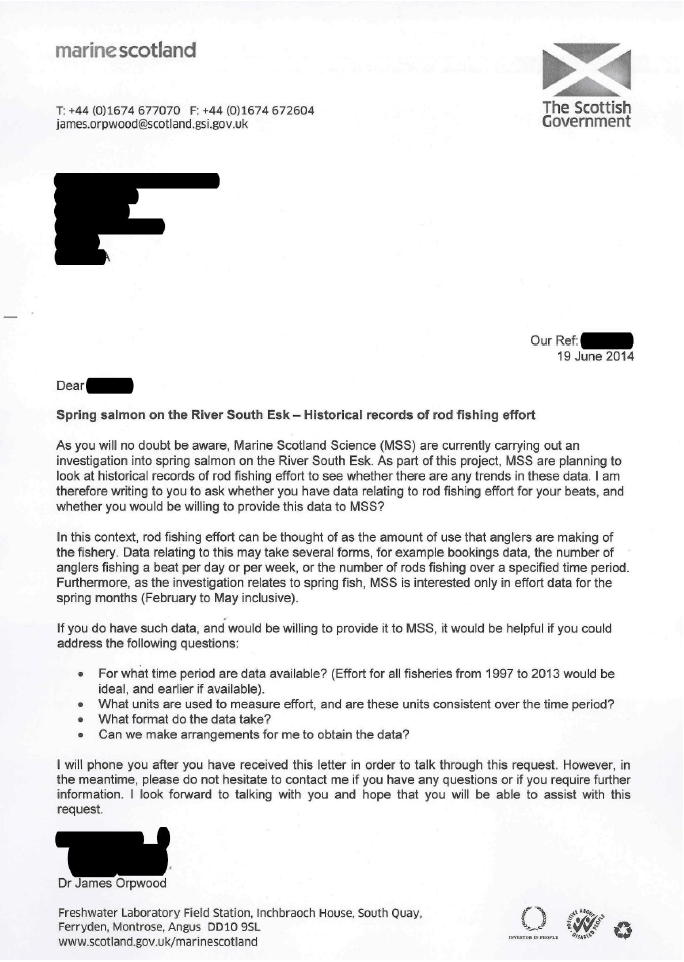
Contact
There is a problem
Thanks for your feedback